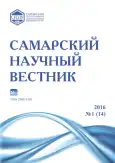Демографические проблемы индустриальных городов Иркутской области в 1990-е годы
- Авторы: Урожаева Т.П.1
-
Учреждения:
- Иркутский государственный университет
- Выпуск: Том 5, № 1 (2016)
- Страницы: 119-124
- Раздел: 07.00.00 – исторические науки и археология
- URL: https://journals.rcsi.science/2309-4370/article/view/22007
- DOI: https://doi.org/10.17816/snv20161210
- ID: 22007
- Дата ретрагирования: 19.09.2017
- Причина ретрагирования:
Дублирование данной статьи в журнале «Урбанистика» №1 2016 г., что нарушает «Этические правила, относящиеся к публикациям в журналах и к рецензиям на них», утвержденные Положением о научном журнале «Самарский научный вестник».
Инициатор: Редакционная коллегия.
Цитировать
Полный текст

Аннотация
В статье автор анализирует проблемы демографического развития промышленных городов Приангарья в 1990-е гг. В частности, акцентируется внимание на негативных тенденциях в естественном и миграционном движении городского населения, которые, в свою очередь, привели к депопуляции. Распределение муниципальных образований Иркутской области по значению общего коэффициента смертности позволяет выделить лишь наиболее общие закономерности. Минимальный уровень общей смертности фиксировался в юго-восточных и центральных районах области, а также в большинстве крупных и средних городов. Наиболее высокие значения общего коэффициента смертности приходились на северные районы области и ряд сельских районов и моногородов центральной и восточной части области. Преимущественно, это депрессивные муниципальные образования, имеющие моноотраслевую экономику. По мнению автора, причины демографической нестабильности индустриальных городов во многом были заложены в советский период и были связаны с практикой привлечения населения и заселения районов нового промышленного освоения. Экономический кризис и обострение социальных проблем в 1990-е гг. серьезно осложнили демографическое развитие городского населения в регионе. Демографический кризис 1990-х гг. можно было заметно сгладить, если бы на уровне федерального центра и региона принимались меры по прекращению устойчивой депопуляции населения. В условиях краха политической системы демографическая политика на долгие годы была отодвинута на второй план. В результате демографический кризис, который зародился еще в 1980-х гг., в полной мере проявился на уровне региона в первое постсоветское десятилетие.
Полный текст
Открыть статью на сайте журналаОб авторах
Татьяна Петровна Урожаева
Иркутский государственный университет
Автор, ответственный за переписку.
Email: olgoy@ya.ru
кандидат исторических наук, сотрудник лаборатории исторической демографии
Россия, ИркутскСписок литературы
- Численность наличного и постоянного населения по городам, рабочим поселкам и районам Иркутской области на 1 января 1994 года и среднегодовая за 1993 год. Иркутск, 1994. С. 20.
- Леньшина И. «Русский крест» над Иркутской областью: Показатели рождаемости и смертности // СМ-номер один. 1998. - 31 марта. С. 2.
- Филиппова В. Время жить иль время умирать // Восточно-Сибирская правда. 1993. - 23 июня. С. 2.
- Винокуров М. Население Иркутской области и трудовые ресурсы // Экономика. Право. Менеджмент. 1999. - 13-19 октября. № 39. С. 5.
- Естественное движение населения в городах Иркутской области в 1990-2000 гг. Иркутск, 1991-2001. С. 34-51.
- Филиппова В. «Хорошо, что все же нас мама родила!»: Стат. данные естественного прироста населения Иркутской области // Восточно-Сибирская правда. 1996. - 28 сентября. С. 4.
- Архив Иркутского областного комитета государственной статистики. Данные о естественном движении городов области. Динамические ряды № 08-03-09.
- Ильина Н. В Саянске демографический подъем // Приокская правда. 1998. - 10 ноября. С. 2.
- Филиппова В. Одна возлюбленная пара: О браках и разводах в Иркутской области // Восточно-Сибирская правда. 1996. - 28 мая. С. 2.
- Овсянникова И. Слабеют узы Гименея или Где найти спутника жизни? // Восточно-Сибирская правда. 2001. - 17 июля. С. 2.
- Основные итоги микропереписи населения в 1994 году. Иркутск, 1995. С. 41.
- Смирнова Е. Иркутская область неотвратимо стареет: О демографической ситуации в Иркутской области // СМ-номер один. 1998. -15 января. С. 2-3.
- Соловьев Ю. Беби-бум в Саянске // Саянские зори. 1998. - 10 ноября. С. 2.
- Кризис бьет по рождаемости // Восточно-Сибирская правда. 1999. - 20 марта. С. 2.
- Стареет город молодой // Время. 2000. - 28 сентября. С. 3.
- Овсянникова И. Приангарье теряет жителей // Восточно-Сибирская правда. 2002. - 5 марта. С. 2.
- Суходолов А. Население Байкальска: демографические и социальные аспекты (1980-1995 гг.) // Байкальский целлюлозник. 1996. - 17 сентября. С. 3.
- Братчан всё меньше // Знамя. 1994. 29 ноября. С. 2.
- Численность наличного и постоянного населения по городам, рабочим поселкам и районам Иркутской области на 1 января 1995. Иркутск, 1995. С. 12-13.
- Монахов В. Прирастаем стариками // Восточно-Сибирская правда. 1999. - 8 июня. С. 2.
- Монахов В. Братск продолжает стареть // Восточно-Сибирская правда. 2000. - 1 августа. С. 3.
- Ретроспективная численность населения по городам и районам Иркутской области в 1989-2002 гг. Статистический сборник. Иркутск, 2006. С. 31-32.
- Стефанович Л. Сколько нас сегодня? // Восточно-Сибирская правда. 1998. - 23 декабря. С. 2.
- Родькина Е. Статистика знает всё // Усть-Илимская правда. 1998. - 25 июля. С. 3.
- Стареем медленно, но верно // Усть-Илимская правда. 2000. - 4 октября. С. 2.
Дополнительные файлы






